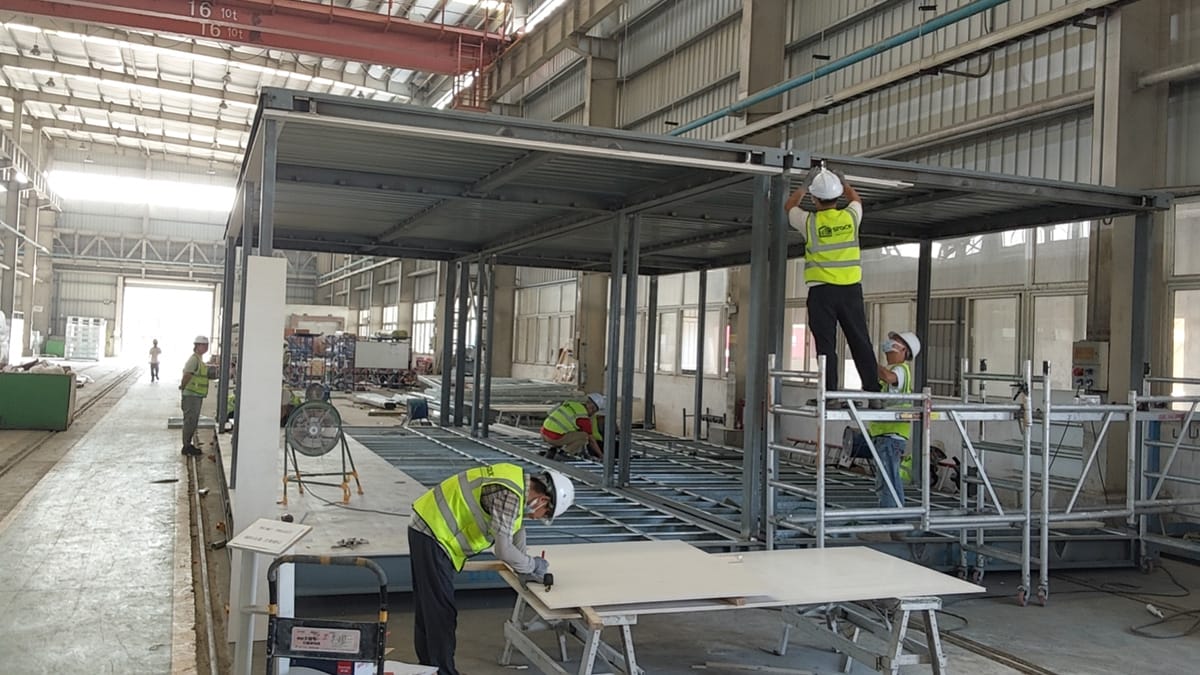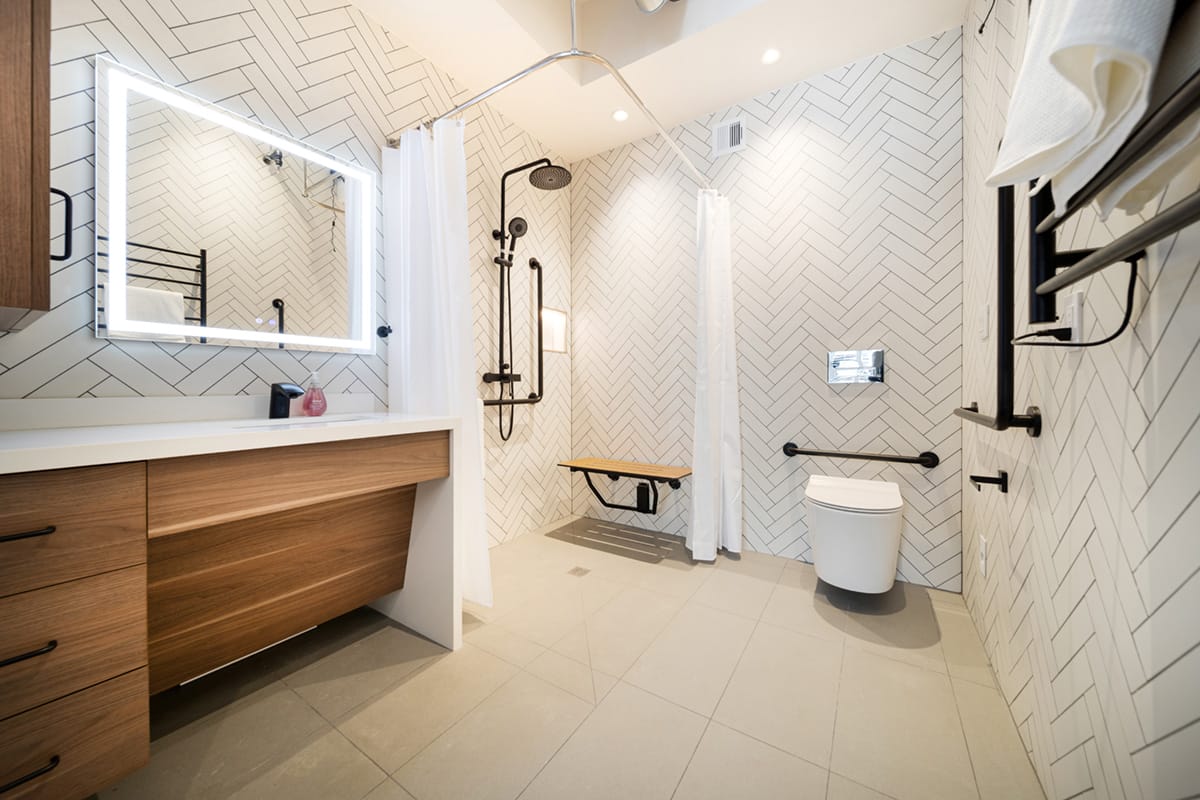One Answer from AI Can Provide Innumerable Opportunities, Says Stack Modular’s Jim Dunn
With access to an abundance of labor and materials, Stack Modular has been able to manufacture modules in China and then ship them out to customers anywhere around the world. Thanks to key port access in Shanghai, there’s no place their modules can’t go. But it was almost a stroke of luck that led to the success of Stack Modular, especially starting in 2008, according to President and Founder Jim Dunn.
Nowadays, Stack Modular relies on its 15 years of experience to fabricate modules for farflung places such as the Arctic Circle (to build a local hotel), the small Pacific Island of Vanuatu (to build a dormitory), and a plethora of locations in North America, their target market.
“For us, no modules ever sit and stay in China,” said Jim.
Manufacturing is thriving at Stack Modular, as the firm recently opened a fourth factory, adding more labor and power to their manufacturing engine. That said, Jim measures success not by the amount of factories the company is running, but by cutting down the time the project spends in the “pre-construction” process.
And he sees artificial intelligence (AI) as the tool to shrink this window of time and transform it into a real business opportunity.

Making the Case for AI at Stack Modular
For Jim Dunn, the need for AI can’t be made clearer. Stack Modular is currently working on constructing and designing the tallest modular building in Canadian history. The 14-story building in Vancouver is a city-owned structure, paid for by the city to help people suffering from homelessness. However, the building is in “pre-construction” limbo.
As Jim points out, there is no single entity to blame for this limbo and ultimately the housing crisis North America is experiencing. But rather, all stakeholders involved in the development process carry responsibility.
“We’re on year four of [this project] and we still haven’t broken ground,” he said. “We’ve just opened a fourth factory. We can get more space, so our issue isn’t shaving a week off manufacturing.”
He cites a number of issues that aren’t just relegated to meeting local zoning restrictions and regulations, but an issue with the process on the whole.
“It’s not just government permits, it’s also the architects trying to design without modular in mind,” he said. “It’s the engineers working in silos, the design [team], and the cumbersome red tape bureaucratic program we’ve created in North America.”
In Stack Modular’s case, they acquired a stake in an architecture firm to simplify design ownership to address one part of the pre-construction phase.
“You can partner with the firm, so now you become an equity partner in the process,” he said. “You’re incentivized and you’re part of the development team. You’re going to the bank and saying, ‘here’s the performance.’ You have to control your destiny there, and [being able to recognize that] comes with years of experience.”
But this was just the tip of the iceberg, in Stack Modular’s case. Jim sees this as an industry-wide issue, and wants to focus on easing the pain for all stakeholders to connect and collaborate.
“[In construction,] North America actually produces less than what we did decades ago,” he said. “So that’s the mentality we’re up against. We’re actually in a system that’s getting slower every day.” This view has been well-documented over the years. News outlets like The New York Times and The Economist have reported on lagging productivity in the construction industry, noting slowdowns from as early as the 1970s.
All of these problems have raised more questions than answers, especially for Jim at Stack Modular.
“How do we make [the pre-construction process] easier and/or simplified now?” he said. “How do we make it also more enjoyable? How do you get these dozens of stakeholders to agree on a building moving forward faster and more efficiently?”
One way to address these problems was to use the litany of technology tools out there, specifically artificial intelligence.


Providing the Fuel for the AI Stack Modular Engine
As Jim explains, AI simplifies the procurement of information and brings it to each decision maker. For example, if an architect sends you five pages of design, you can ask AI to review the pages to tell you how much drywall you need.
But even AI has its limitations—most notably with its source of information, as many have experienced with the use of ChatGPT and Google’s Gemini AI.
“When your engine is the web,” says Jim, you can ask it anything about anyone and pull up basic information that you need. “But in our world, I can’t ask ChatGPT how much drywall I need in the building.” What was Jim’s solution to the problem? To build their own Stack Modular AI engine.
When to Build New and When to Adopt
Jim has always been an early adopter of new technology, familiarizing himself with the first version of ChatGPT by downloading it onto his phone. But it wasn’t until a Harvard lecturer gave a talk to a group of business leaders that Jim was inspired to bring AI to Stack Modular.
That was about a year ago, when “the proverbial hamster wheel started running,” he said. Soon after, Stack Modular obtained the corporate license for Google’s Gemini AI chatbot. That led to various teams adopting some smaller plug-ins or add-ons to existing programs to eliminate some more rote design work.
“There’s some really nice artistic toolings from AI, like with generative facade structuring,” he said. “So rather than us building our own engine that can create a beautiful picture of a building, we’ll have this add-on that’s already existed.”
With software, chances are there are already some small tools and solutions available to fix very specific problems you might have, says Jim. The difference in applying AI to your business, especially in modular, has to do with the information you have accessible to insert into your AI engine for use.
“The proprietary opportunity was realizing that AI, in the global sense of the word, isn’t actually going to do much for us, but a Stack AI Engine would be a game changer,” he said. “Unfortunately, that comes with radical higher costs, as you’re building your own engine. It’s just a lot of work to get the Stack Engine [up].”
The company is committed to building out the Stack AI Engine to revolutionize the pre-construction process. They’ve hired a full-time consultant well-versed in the Google ecosystem to help develop decision-useful AI programs.
“Our team is full of amazing engineers, architects, builders, manufacturers, but they don’t know anything about AI,” he said, and vice versa. “So just combining the two groups for a pretty penny under the same roof has been essential and we’re nowhere near where we need to be, but we’re certainly closer today than yesterday.”



Stack AI Engine Benefits are Limitless
Right now, AI can help with digital admin work, such as naming files and providing readily accessible information on the web in a snap. However, building a useful AI tool requires that fountain of knowledge and 15 years of experience in order to be applicable in modular.
The Stack AI Engine is not fully functional yet, but it offers an unlimited number of productivity benefits. One particular function is the ability to scan dense project requirements—using past projects at Stack Modular—to spit out relevant information, says Jim. Currently, the company is using AI for cost estimates, most recently for a project out in California.
“If the client adds a floor, AI tells me immediately how much more drywall I need, as an example. We can then relay this cost change to the developer in seconds.” he said.
AI has provided some success from the get-go, but more remains to be done at Stack Modular, said Jim. As part of building the Stack AI Engine, Jim has asked his teams to get their noses off the grindstone and give AI access and insight into every part of their day-to-day roles.
“The biggest limitation is getting them out of that role, which I’ve trained them for 15 years to do and say, ‘pause, stop being great for a second, and go backwards,’” he said. “‘Get this AI engine, Google Drive, all set up.’ That’s been the hardest, getting people to realize that we got to take a step backwards to go step forward.”
Using AI to Transform the Modular Industry on the Whole
As Jim continues to work on the Stack AI Engine, he is also aware of some of the pervasive attitudes in some corners of the modular industry.
“I wish my module partners of the world would be more open-minded and think how rising tides raise all ships, but they don’t,” he said. “We actually have a housing crisis. So if we could check our egos at the door and share some of the lessons learned—the AI victories and experience in our case, which is the fuel for AI—I’m happy to do it.”
Even with that sentiment, he is also aware of the narrower area of operation that Stack Modular has settled on. Some companies may be more inclined to bring AI to the manufacturing plant to shorten time in the factory, but that’s not where Stack Modular’s focus is, according to Jim.
“I would say an opportunity for us to share and win as an industry, both in modular and construction, would be ‘how can we utilize AI for the collaborative efforts that pre-construction requires?’” said Jim.
The future could be much brighter and collaborative, he says. Through showing, rather than telling, the modular industry has a better chance of growing.
“Imagine this,” Jim says. “Stack offers a login name to an architect and developer with little to no modular experience. And by using our Stack AI Engine, they are able to design, manipulate, change and even price a TRUE modular project, without a Stack engineer in the room. That is where we need to be, and frankly, Stack will be in 2025.”
About the Author: Karen P. Rivera is a freelance writer and editor with a passion for storytelling. She is a former United Nations-based reporter, with experience covering international breaking news, venture capital, emerging healthcare tech, and the video game industry.
More from Modular Advantage
Resia: Breaking All the Rules
Resia Manufacturing, a division of U.S.-based Resia, is now offering prefabricated bathroom and kitchen components to industry partners. Its hybrid fabrication facility produces more precise bathroom and kitchen components (modules) faster and at lower cost than traditional construction. Here’s how Resia Manufacturing does it.
How LINQ Modular Innovates to Bring Modular To The Market in the UAE and Beyond
LINQ Modular, with an office and three manufacturing facilities in Dubai, is a modular firm based in United Arab Emirates. The company is on a mission: to break open the housing and construction markets in the Gulf Cooperation Council (GCC) area with modular.
ModMax: Redefining Modular Construction with Confidence and Precision
ModMax was born out of frustration—frustration with five persistent pain points in modular construction: Permitting bottlenecks. Production delays. Rigid designs. Disconnect between “the office” and the field. Lack of transparency and communication.
LifeArk: Disaster-Resilient Housing from Recycled Plastic and 100-year-old Technology
Wee compares LifeArk’s housing units to Yeti coolers, as they are built similarly. Each component takes 15 to 20 minutes to manufacture, has an R-value of 40, and includes molded slots and chases for wiring, plumbing, fire sprinklers, and other utilities.
Building the Future of Modular Edge Infrastructure
The edge data center market is expanding rapidly, driven by the surge in AI workloads, IoT adoption, and the need for localized compute power. In these environments, sustainability, scalability, and reliability are non-negotiable. Cooling is among the most complex challenges for operators—and one of the most decisive factors in long-term success.
Accelerating Light-Gauge Steel Construction: A Semi-Automated Digital Workflow for Off-Site Projects
For construction professionals, the message is clear. By adopting semi-automation and digitalization, companies can deliver projects faster, more accurately, and more profitably, while also building stronger collaboration across teams. The approach is not about replacing people with machines, but about empowering people with better tools and processes.
Why Modular Data Centers Are Gaining Momentum
Artificial intelligence, high-performance computing, and edge applications push the limits of traditional “stick-built” data centers. They take years build, often struggle with high density workloads, and aren’t optimized for deployments near end users. Modular data center platforms are purpose-built to address these challenges, offering flexibility and scalability to adapt to evolving technologies, while opening new opportunities for the modular construction industry.
Supply Chain Innovation in Action: 5 Habits Every Modular Leader Should Practice
By applying these principles to supply chain practices — collaborative planning, strategic procurement, scenario modeling, digital tools, and transparent forecasting — construction leaders can build value chains that are not just efficient and agile, but truly innovative.
Exploring the Role of Modular Integrated Construction (MiC) in Advancing Circular City Principles – A Survey of Stakeholder Perspectives
The survey findings highlight the significant potential of Modular integrated Construction (MiC) in advancing the development of circular cities. By reducing costs, accelerating construction timelines, and minimizing waste generation, MiC offers a promising approach to sustainable urban development.
The Use of MS POLYMER™-Based Sealants and Adhesives in Modular Building
These products combine flexibility and elastic recovery with excellent adhesion to different substrates and have already shown their usefulness in traditional construction. Now it’s time for them to be put to use in the modular construction industry.










